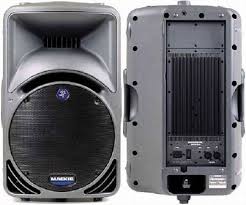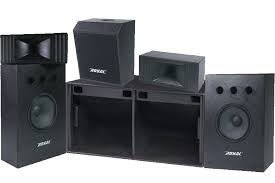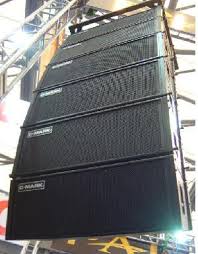
This simple question cannot be answered quite so simply. In order to better understand why loudspeakers sound different, we need a bit more information. There are different parts to the puzzle. Therefore, we need to look at each part in order to see the whole picture.
Different Listening Environments
If you have ever traveled with a music ministry team, you know that your sound system will sound different in almost every auditorium, sanctuary, fellowship hall and gymnasium that you encounter. Put the same sound system outdoors and a completely different sound occurs. What usually has the most impact on sound character is the acoustical nature of the room.
Let’s suppose I am a member of my church’s sound committee and we are searching for an updated sound system. During the investigative process, I attend a performance at the local high school auditorium and am impressed by the fact that one single loudspeaker can seemingly fill the room with natural sound at a good listening level. I then report at the next committee meeting that I have discovered the loudspeaker that will work “wonders” in our sanctuary. You know the rest…we buy the same loudspeaker and install it in our sanctuary only to find that we cannot understand a single word that is spoken. What went wrong?
We did not take into account how that particular loudspeaker interacts with our particular room. That one loudspeaker may have “filled” the room because it spreads out sound energy to a very large area. This would be acceptable if the room acoustics tend to be very dry, meaning low reverberation. However, putting that same loudspeaker in our worship space, which has a very large room volume, hard reflective walls, floor and ceiling, resulted in disaster. For our worship space, a loudspeaker that is more directional (controlling more of the sound energy to one defined area) would be required to keep sound from reflecting off the hard surfaces of the room. We need to keep more of the sound energy directed at the listening audience rather than at the ceiling.

"When a loudspeaker is hung in mid-air,
away from the ceiling, floor, and walls,
it will have the least amount
of bass response."
Same Loudspeaker in Different Locations in the Same Room
You may have experienced this at home after moving your stereo system loudspeakers to different locations in the same room. Perhaps you noticed a change in the low-frequency or bass response. To get the same tonal balance, you had to adjust the bass tone control up or down. This is due to an acoustical principle where room boundaries are involved. For example, when a loudspeaker is hung in mid-air, away from the ceiling, floor, and walls, it will have the least amount of bass response. This location is called free-space loading of the loudspeaker. Now move that same loudspeaker to the floor (one room boundary) and you will notice a 3 dB increase in bass response, which is a noticeable increase. This is called half-space loading. Now move that same loudspeaker to the middle of one wall and keep it on the floor. The loudspeaker is now at a point where two room boundaries meet (the wall and floor). You will hear another 3 dB in bass response, or 6 dB more bass response than the free-space location. This is due to the quarter-space loading. You can probably guess what happens when you move the loudspeaker to the corner where three room boundaries meet (floor and two walls OR ceiling and two walls). You will experience another 3 dB increase in bass response due to the eighth-space loading of the loudspeaker. The bass response at this location is now 9 dB louder than when the loudspeaker was hanging in free air . This is almost twice as loud at bass frequencies.
You may have also noticed a change in the overall sound quality when you moved the loudspeaker close to a hard reflective wall or ceiling. The reason for this is some of the mid-range and high-frequency sound energy is reflected off the wall or ceiling and back to the listener. The reflected sound arrives slightly after the direct sound. The combined sound energy results in a change in the overall tonal quality. Whether this reflected energy makes the loudspeaker sound better or worse is dependent on how far from the wall or ceiling the loudspeaker is located and the material composition of the wall. A hard, flat gypsum wall will reflect energy differently than a rough stone wall.

Loudspeakers Played at Different Loudness Levels
When comparing two different loudspeakers, you will want to listen to them at the same loudness levels. What is often overlooked is how the same loudspeaker will sound at different loudness levels.
One attribute of a well-designed sound system is its ability to maintain a natural, consistent quality when reproducing soft or loud sounds. Every loudspeaker will sound bad when turned up too loud (distortion) and some loudspeakers only sound good at certain loudness levels. These findings may not be relevant in a traditional liturgical service. However, turning up the sound system loud enough to be heard over a full congregation worshipping at the top of their lungs may cause the sound system to sound harsh.
Different Sound Sources
Listen to a well-recorded Mahler symphony on a pair of very expensive electrostatic loudspeakers. You may be impressed by the sonic experience. However, you may not be so impressed with those same loudspeakers when using them as the main loudspeakers in your sound system, reinforcing a large, contemporary worship team with a full complement of drums and electronic instruments. It is of utmost importance to plan for every conceivable type of sound source that you may encounter when considering loudspeakers for your facility.
Different Sound Operators

One other factor that will influence different sound quality is the sound system operator. For instance, if you have the same person mix and adjust the sound system for every event in your facility, chances are you will have very consistent sound from week to week and service to service. Having the same sound system operator, however, is very impractical for many churches. If you have more than one sound system operator, the sound system may sound different each time you have a service or event. Making certain that all of your operators are equally trained is one way to avoid this. An additional approach would be to assign one individual as a “producer” to provide constructive direction to the sound crew. This particular person does not have to be technically oriented. However, one needs to have good hearing and have a humble, servant-minded interest in how things sound.
Different Loudspeakers Designed for Different Purposes
Using a large, horn-loaded loudspeaker that was designed for an outdoor stadium in a small, intimate 200-seat chapel would be very unpleasant at best. The voices would sound harsh, and musical instruments, especially the piano, would sound strident and unnatural.

Loudspeakers that are designed to spread background music in every direction in a restaurant would probably produce howling feedback and indistinct speech in most worship spaces. Loudspeakers are complex mechanical de-vices. If design engineers make a decision on how to build a loudspeaker, they are usually trading one performance characteristic for another. When generating a lot of sound level in a specific direction outdoors is the primary objective, the engineer will consider the tonal balance and natural sounds reproduction of the loudspeaker to be of low priority. When the loudspeaker is designed for speech-only applications, such as paging and voice announcement, accurate music playback is not important in the design and manufacturing of the device.
Different Manufacturers’ Products
When a loudspeaker manufacturer begins to design a product, they often include input from sales representatives, dealers, key customers and end-users of similar products. When numerous people are involved with the development, the loudspeaker that is built will obviously sound different from the same type of product built by a different group of engineers and/or consulting team.
Different Electronics and Power Amplification
The quality of electronics and power amplifiers should be similar to the quality of the loudspeaker. While it is true that more attention and expenditure should be paid toward the loudspeakers and microphones in the sound system, a reasonable quality standard should be maintained for the system electronics and power amplifiers.
Some electronics are noisier than others. At higher levels, some electronics will distort sooner than others. Different power amplifiers will control low-frequency (bass) loudspeakers better than others. One certainly would not purchase a pair of $10,0000 studio monitor loudspeakers and power them with a $100 “build-it-yourself” kit amplifier. You would not want to skimp on loudspeaker cabling either. The gauge or size of the loudspeaker cable must be sufficient to transfer power and maintain control of the loudspeaker.
The Big Picture
Keep in mind that there is more to selecting a loudspeaker than reading a brochure, listening to loudspeakers at a retail store, or choosing a product on price alone. As you have seen, loudspeakers sound different for a variety of reasons. Make certain you find a contractor who knows all the pieces to the puzzle so you get the whole picture and nothing but the picture.
by Ron Huisinga

No comments:
Post a Comment